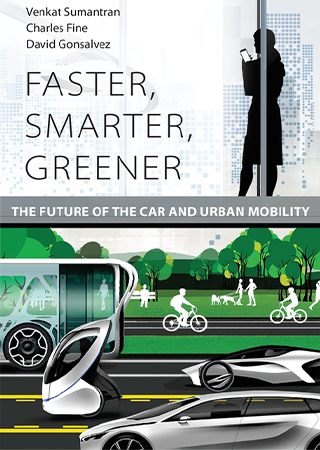Faster, Smarter, Greener
An in-depth look at the future of the car and urban mobility
The world economy grew at more than 5 percent annually in the 1960s and has since gradually slowed to less than 3 percent.
Between 2007 and 2011, new car sales to people aged 18 to 34 declined by almost 30 percent. Mobility was slowly getting more expensive, and this too played an important role.
In 1950, the average car sold for about 45 percent of average annual family income. In 2014, the equivalent family had to spend 61 percent of its annual income for the car. The average American family spent almost 50 percent more on transportation – almost $9,000 annually – than they did on food. Even for those comfortably in the middle-income segments, transportation costs accounted for almost a fifth of income.
Transitioning to the new digital era
Digital technologies have changed the meaning of “mobile.” Cellular telephones transformed communication and offered an alternative to people moving from one location to another. Growing up in the age of Facebook, selfies and Instagram, modern users have become accustomed to products and services catered around their personal tastes and greater freedom in expressing their personalities.
A U.S. survey by Cisco in 2011 revealed that two-thirds of college students preferred the utility of an Internet connection over the use of a car. Such a transformation in expectations signals a readiness to adopt new forms of mobility and an oncoming upheaval for the auto industry.
At the same time, driving went from being a source of fun to a chore during which the driver’s attention had to be focused on mundane duties, often for a large fraction of a commuter’s free time. To many, this was valuable time robbed from more productive uses or entertaining engagements with a smartphone. Familiarity with the automobile had eroded its novelty.
A Millennial outlook on mobility
The attitudes of these “digital natives” toward mobility are shaped by their preference for urban living, familiarity with technology and their experience of economic headwinds. According to a Nielsen survey, “Millennials are walkers and less interested in the car culture that defined Baby Boomers.”
Of those surveyed, 62 percent preferred to live in urban, mixed-use communities and walk to work and shops.
In 2007, 77 percent of U.S. adults younger than 25 owned a car. By 2011, this figure had dropped to 66 percent.
Furthermore, faced with a high level of accidents and fatalities involving young drivers, many states in the U.S. enacted graduated driving license laws imposing more restrictions and higher costs on new drivers. Gone were the days of the 16 year old informally indoctrinated into driving by parents or siblings.
The more cumbersome process, coupled with the higher costs of acquiring a license and insurance, created further disincentives for many Millennials.
A pattern that has repeated across the U.S., Europe and Japan reveals that fewer of the young populations acquire driver’s licenses or have access to a car, and consequently they drive less annually.
Growth of e-commerce
For many infrequent drivers, one major use of cars has been for noncommuting activities such as shopping or entertainment.
With the increase in online shopping, the usefulness of a car for shopping has declined. Across Europe too, online retail sales have grown at more than 18 percent per year, well above the rate of conventional retail sales.
The growth may be even more impressive in emerging economies.
These services target tech-savvy young professionals who are hard-pressed for time. With no need to stop at a supermarket on the way home, many commuters may actually find public transit a viable alternative. Because of their greater comfort with the internet, smartphones and the digital economy, younger consumers are more likely than older ones to shop online.
With shopping, dining and entertainment available with just a few clicks and online applications finding growing adoption, it is no surprise that the role of the car has shrunk.
Comprehending mobility
As society attempts to configure the architecture of future mobility, it is important to comprehend how significantly the mobility needs of people and their communities are changing.
Furthermore all affairs need to be sustained by novelty, and people’s running love affair with cars shows signs of weariness.
These factors, together, demand a transformed mobility architecture, and cars will likely play a less prominent role in this future.
To learn more or purchase Faster, Smarter Greener, visit MIT Press.
Venkat Sumantran is Chairman of Celeris Technologies, with more than 30 years of experience heading organizations in the auto industry in the United States, Europe and Asia.
Charles Fine is Chrysler LGO Professor at MIT Sloan and the Founding President of the Asia School of Business, Kuala Lumpur
David Gonsalvez is CEO and Rector at MIT’s Malaysia Institute for Supply Chain Innovation.



